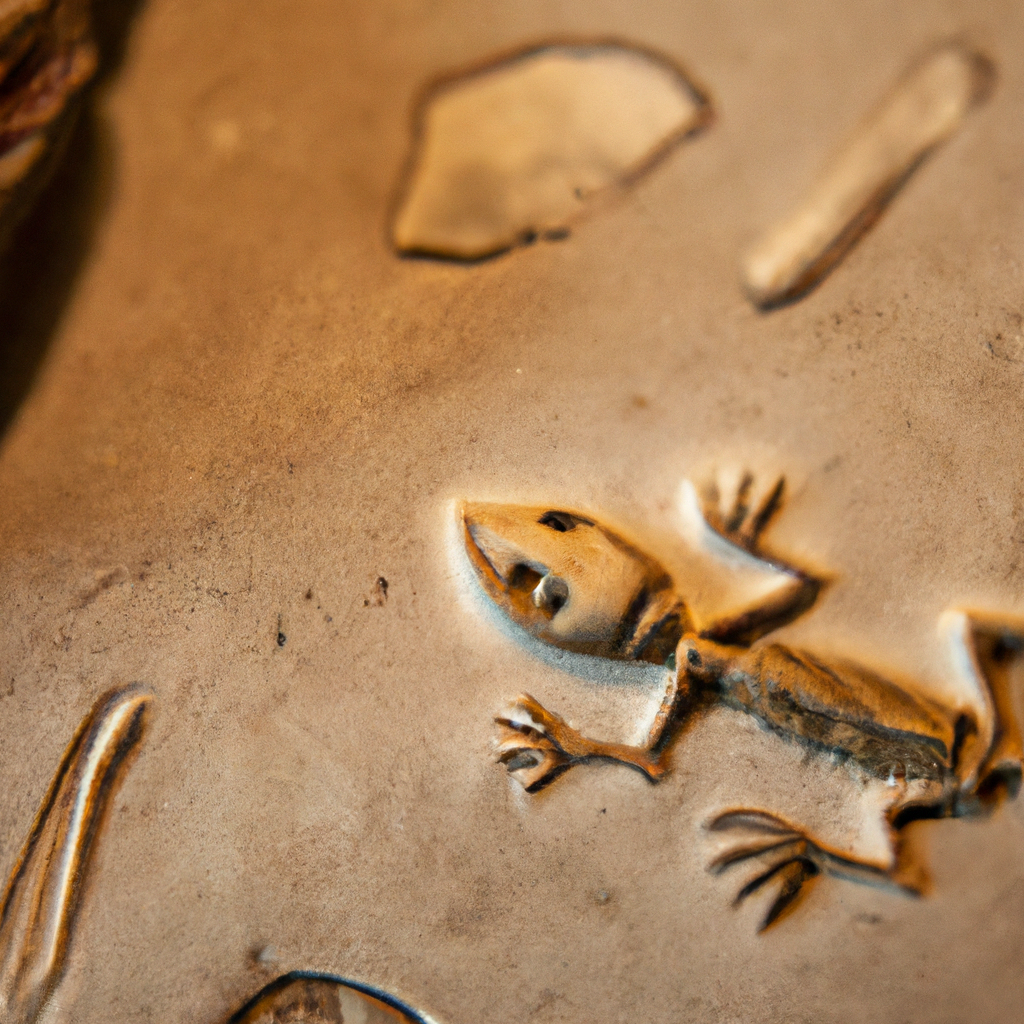Introduction to Lizard Artifacts and Fossils
Lizard artifacts and fossils offer a captivating glimpse into the ancient world, providing valuable insights into the history and evolution of these fascinating creatures. These artifacts, ranging from intricate carvings to pottery featuring lizard motifs, serve as tangible links to past civilizations that revered and celebrated these reptiles. Fossils, on the other hand, offer a more scientific perspective, shedding light on the biological aspects of lizards and their role in ecosystems throughout history.
The study of lizard artifacts and fossils is not just limited to archaeologists and paleontologists; it also captures the imagination of enthusiasts and collectors worldwide. Each artifact tells a unique story, whether it be a symbol of luck and prosperity in a particular culture or a representation of a deity in ancient mythologies.
By delving into the world of lizard artifacts and fossils, we gain a deeper appreciation for the intricate craftsmanship of ancient civilizations and the biodiversity of prehistoric landscapes. These artifacts serve as a tangible link to our past, allowing us to connect with the beliefs, practices, and artistic expressions of bygone eras.
As we explore the rich tapestry of lizard artifacts and fossils, we embark on a journey through time, unraveling the mysteries of the past and gaining a greater understanding of the cultural, artistic, and scientific significance of these remarkable relics. Whether displayed in museums, studied in academic settings, or cherished in private collections, lizard artifacts and fossils continue to captivate and inspire, bridging the gap between the ancient world and the present day.
History of Lizard Artifacts
The history of lizard artifacts is a fascinating journey through time that sheds light on the relationship between humans and these reptilian creatures. Lizard artifacts have been discovered in various parts of the world, providing valuable insights into ancient civilizations and their beliefs. Dating back thousands of years, these artifacts offer a glimpse into the cultural significance of lizards in different societies.
In ancient Egypt, for example, lizards were often associated with protection and rebirth. Lizard-shaped amulets and figurines have been found in tombs, symbolizing the eternal cycle of life and death. In Mesoamerican cultures like the Aztecs and Mayans, lizards were revered for their agility and ability to adapt to different environments. Artifacts depicting lizards in these civilizations often symbolized transformation and renewal.
Lizard artifacts have also been discovered in archaeological sites across Europe and Asia, revealing the widespread presence of these creatures in various cultures throughout history. From intricate jewelry designs to pottery decorations, lizards have been a common motif in art and symbolism.
Studying the history of lizard artifacts provides important clues about the beliefs, practices, and daily lives of ancient peoples. These artifacts not only serve as historical artifacts but also as a testament to the enduring fascination with lizards and their symbolic meanings. By exploring the origins and evolution of lizard artifacts, we can gain a deeper understanding of human culture and our enduring connection to the natural world.
Significance of Lizard Fossils
The significance of lizard fossils lies in their ability to provide valuable insights into the evolution and history of these fascinating creatures. By studying these ancient remains, scientists can uncover crucial information about the biodiversity, environmental changes, and adaptations of lizards over millions of years.
Lizard fossils offer a window into the past, allowing researchers to trace the evolutionary lineage of various lizard species and understand how they have adapted to different environments throughout history. These fossils can reveal important details about the size, shape, and behavior of ancient lizards, shedding light on their interactions with other species and their role in past ecosystems.
Moreover, the study of lizard fossils can help scientists piece together the puzzle of Earth’s geological history. By examining the distribution of lizard fossils across different geological layers, researchers can reconstruct past climates, habitats, and tectonic movements that have shaped the planet over time.
Additionally, lizard fossils have cultural significance for many communities around the world. In some cultures, lizards are considered symbols of luck, protection, or spirituality, and the discovery of lizard artifacts can hold special meaning for these societies. Understanding the cultural beliefs and practices associated with lizard fossils can provide a more holistic view of human-animal relationships throughout history.
Overall, the significance of lizard fossils extends beyond their scientific value, offering a multifaceted perspective on the natural world and the interconnectedness of living beings throughout time.
Where to Find Lizard Artifacts
Exploring where to find lizard artifacts can lead to exciting discoveries in the field of archaeology. Lizard artifacts can be found in various locations around the world, each offering unique insights into the ancient civilizations that once existed.
Archaeological sites with lizard artifacts are often located in regions known for their rich biodiversity and historical significance. These sites may include caves, rock formations, burial grounds, and ancient settlements where artifacts are unearthed through careful excavation and research.
In some cases, lizard artifacts are discovered by amateur fossil hunters or local community members who stumble upon them while exploring the countryside. These chance discoveries can provide valuable clues about the past and contribute to our understanding of ancient cultures and their interactions with lizards.
Museums and research institutions also play a crucial role in the preservation and study of lizard artifacts. They often house extensive collections of artifacts and fossils, allowing researchers and the general public to learn more about these fascinating relics.
Additionally, advancements in technology have enabled archaeologists to use tools such as ground-penetrating radar and 3D scanning to locate and analyze lizard artifacts with greater precision. These tools help researchers map out archaeological sites and uncover hidden artifacts that may have been previously overlooked.
Overall, the search for lizard artifacts continues to be an exciting and rewarding endeavor that sheds light on the ancient world and its connection to the fascinating reptiles that have captivated human interest for centuries.
Types of Lizard Artifacts
Lizard artifacts come in various forms, each offering unique insights into the ancient world of these fascinating creatures. One common type of lizard artifact is petroglyphs, which are rock carvings or engravings created by ancient civilizations depicting lizards in symbolic or artistic representations. These petroglyphs provide valuable clues about the cultural significance of lizards in different societies and time periods.
Another type of lizard artifact is pottery or ceramics adorned with lizard motifs. These artifacts showcase the artistic skills and creativity of ancient craftsmen who incorporated lizard designs into their pottery, serving both functional and decorative purposes. By studying these pottery pieces, researchers can gain a better understanding of the cultural beliefs and practices related to lizards in the past.
Lizard fossils are also important types of artifacts that offer insights into the evolutionary history of these reptiles. Fossilized remains of ancient lizards provide scientists with valuable information about the anatomy, behavior, and habitats of these prehistoric creatures. By examining fossilized bones, teeth, and imprints, researchers can reconstruct the evolutionary timeline of lizards and uncover important details about their adaptation and survival strategies over millions of years.
In addition to petroglyphs, pottery, and fossils, other types of lizard artifacts include jewelry, amulets, and figurines featuring lizard motifs. These artifacts often hold symbolic meanings related to protection, fertility, or spiritual beliefs, shedding light on the cultural significance of lizards in different civilizations. Overall, the diverse range of lizard artifacts offers a rich tapestry of knowledge about the relationship between humans and lizards throughout history.
Importance of Preserving Lizard Fossils
Preserving lizard fossils is crucial for unlocking the secrets of the past and understanding the evolution of these fascinating creatures. By carefully documenting and safeguarding these ancient remains, researchers can study the morphological features, behaviors, and habitats of prehistoric lizards. Preserving lizard fossils also allows scientists to analyze changes in lizard populations over time, providing valuable insights into environmental shifts and biodiversity patterns.
One of the key reasons for preserving lizard fossils is to contribute to the field of paleontology and evolutionary biology. These well-preserved remains serve as valuable specimens for scientific research, enabling experts to reconstruct the evolutionary history of lizards and trace their development through geological time. By studying the fossilized remains of ancient lizards, researchers can gain a better understanding of how these reptiles adapted to different environments and climates over millions of years.
Furthermore, preserving lizard fossils helps in conservation efforts by highlighting the importance of protecting modern lizard species and their habitats. By learning from the past, conservationists can develop strategies to safeguard endangered lizard species and prevent further biodiversity loss. Preserved fossils serve as a reminder of the rich diversity of lizard species that have existed throughout history, emphasizing the need to conserve these remarkable creatures for future generations to appreciate and study.
In summary, the preservation of lizard fossils plays a crucial role in advancing scientific knowledge, preserving biodiversity, and promoting environmental conservation. By recognizing the significance of these ancient remains, we can gain valuable insights into the history and evolution of lizards while also appreciating the importance of protecting these unique creatures and their habitats.
Recent Discoveries in Lizard Archaeology
Recent Discoveries in Lizard Archaeology
In recent years, the field of lizard archaeology has seen exciting developments with the discovery of new artifacts and fossils shedding light on the history and evolution of these fascinating creatures. Researchers have unearthed a wealth of information that has expanded our understanding of ancient lizard species and their habitats.
One significant discovery in lizard archaeology is the finding of well-preserved lizard fossils in previously unexplored regions. These fossils provide valuable insights into the biodiversity and behavior of prehistoric lizards, helping scientists piece together the puzzle of their evolutionary history. By studying these fossils, researchers can trace the lineage of different lizard species and identify key adaptations that have allowed them to thrive in various environments.
Another area of interest in recent lizard archaeology discoveries is the examination of ancient lizard artifacts. These artifacts, ranging from intricate carvings to ceremonial objects, offer clues about the cultural significance of lizards in past societies. By analyzing these artifacts, researchers can gain a deeper understanding of how lizards were perceived and utilized by ancient civilizations.
Furthermore, advancements in technology have enabled researchers to conduct more detailed analyses of lizard artifacts and fossils. Techniques such as radiocarbon dating and CT scanning have allowed scientists to accurately determine the age of artifacts and study their internal structures without causing damage. These technological advancements have greatly enhanced our ability to extract valuable information from lizard remains, pushing the boundaries of what we can learn from these ancient treasures.
Overall, recent discoveries in lizard archaeology have enriched our knowledge of these enigmatic creatures and provided new avenues for research and exploration in the field. By continuing to uncover and study lizard artifacts and fossils, we can unlock the secrets of the past and gain a deeper appreciation for the diversity and resilience of lizards throughout history.
Methods of Dating Lizard Artifacts and Fossils
Dating lizard artifacts and fossils is a crucial aspect of understanding their historical context and significance. Several methods are employed by archaeologists and paleontologists to determine the age of these discoveries. One common technique used is carbon dating, which involves analyzing the amount of carbon-14 present in organic materials such as bones or wood. By measuring the decay of carbon-14, scientists can estimate the age of the artifact or fossil.
Another method utilized for dating lizard artifacts and fossils is stratigraphy, which involves studying the layers of sediment where the artifacts are found. By analyzing the position of the artifacts within these layers, researchers can establish a relative chronology of when they were deposited. This helps in determining the sequence of events and the age of the artifacts in comparison to each other.
Additionally, thermoluminescence dating is used for artifacts that contain minerals like quartz or ceramics. This method measures the amount of trapped electrons in these materials, which are released when the artifact is heated. By analyzing the luminescence emitted, scientists can calculate the age of the artifact.
Furthermore, dendrochronology, or tree-ring dating, is employed for artifacts made from wood. By examining the growth rings of the wood, researchers can determine the age of the artifact and gather information about the climate and environmental conditions during the time it was created.
Overall, the methods of dating lizard artifacts and fossils play a vital role in piecing together the puzzle of the past and shedding light on the history and evolution of these ancient creatures.
Cultural Beliefs and Lizard Artifacts
Lizards have held symbolic significance in various cultures around the world for centuries. In many cultures, lizards are believed to represent different concepts such as fertility, transformation, protection, and good luck. The presence of lizard artifacts in archaeological sites often sheds light on the spiritual beliefs and practices of ancient civilizations.
For example, in some Native American cultures, lizards are seen as symbols of renewal and regeneration. Artifacts depicting lizards may have been used in ceremonial rituals to invoke these qualities or to offer protection to the community. Similarly, in ancient Egyptian culture, the lizard was associated with the concept of rebirth and resurrection, often depicted in art and hieroglyphics.
In other cultures, lizards are believed to be messengers between the physical and spiritual worlds. Their ability to shed their skin and regenerate has led to associations with transformation and renewal. This symbolism is reflected in the use of lizard motifs in jewelry, pottery, and other artifacts found in archaeological excavations.
Studying cultural beliefs surrounding lizard artifacts provides valuable insights into the spiritual and symbolic realms of past civilizations. It allows us to better understand how these ancient cultures perceived the natural world and how they incorporated their beliefs into everyday life. By examining the cultural significance of lizard artifacts, we can gain a deeper appreciation for the diverse ways in which humans have interacted with and revered these fascinating creatures throughout history.
The Fascinating World of Lizard Artifacts and Fossils
The study of lizard artifacts and fossils offers a captivating glimpse into the ancient past, shedding light on the diverse cultural beliefs and practices associated with these creatures. Throughout history, lizards have held symbolic significance in various cultures around the world. From being revered as symbols of regeneration and renewal to representing protection and good fortune, lizards have played a significant role in shaping the spiritual beliefs of different civilizations.
In many ancient societies, lizards were considered sacred beings that bridged the gap between the earthly realm and the spiritual world. They were often depicted in art, mythology, and religious rituals as powerful symbols of transformation and regeneration. The intricate carvings and representations of lizards on artifacts and fossils provide valuable insights into the cultural beliefs and practices of past civilizations.
Furthermore, the presence of lizard motifs on ancient artifacts and fossils highlights the importance of these creatures in the daily lives of people from diverse cultures. Whether used in ceremonial rituals, as decorative motifs, or as symbols of protection, lizards held a special place in the hearts and minds of ancient societies.
By exploring the cultural beliefs and practices surrounding lizard artifacts and fossils, we gain a deeper understanding of the interconnectedness between humans and the natural world. These artifacts serve as tangible links to our shared history, offering a window into the rich tapestry of beliefs and traditions that have shaped societies throughout time. As we continue to unearth and study these artifacts, we uncover the fascinating stories and cultural significance that lizards held in ancient civilizations.




